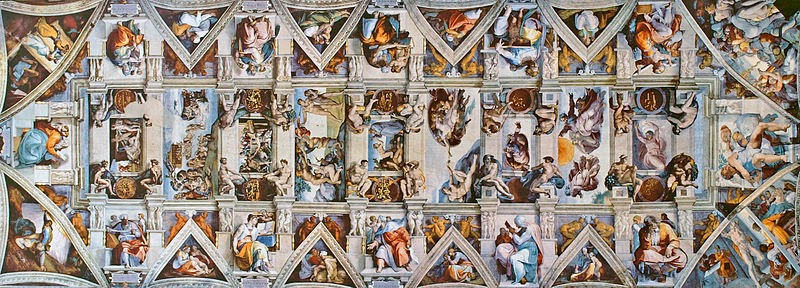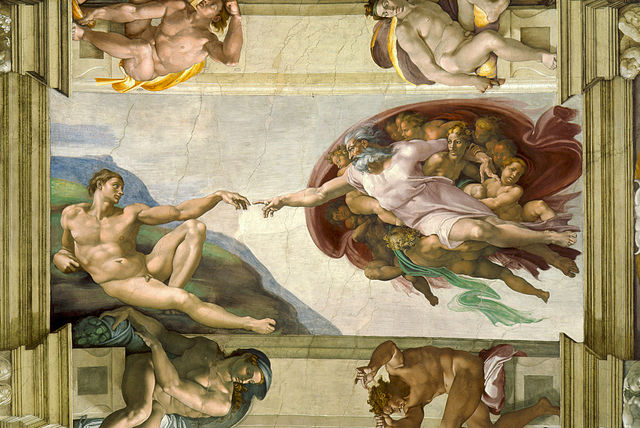
The ceiling of the Sistine Chapel
On November 1, 1512, Michelangelo Buonarotti removed the scaffolding from the Sistine Chapel and revealed his famous masterpiece frescoes on the ceiling. It is considered a cornerstone work of High Renaissance art.
“No one who has not seen the Sistine Chapel can have a clear idea of what a human being can achieve.”
– Johann Wolfgang von Goethe (1786), as quoted in [9]
Planning Sistine Chapel’s ceiling
Pope Julius II was known to be investing much to emphasize the political role of the Church and started to rebuild St. Peter’s Basilica in 1506. In the same year, he started his program to paint the Sistine Chapel’s ceiling. When Michelangelo was occupied with this work, he had basically no choice and signed his contract two years later. Originally, the pope planned twelve larger figures but Michelangelo was eventually allowed to create his own design, which resulted in over three hundred figures and took four years to execute.
An unusual procedure
Before starting to paint, Michelangelo had to build his own scaffold but still, the working conditions were incredibly uncomfortable as he was standing and looking towards the ceiling for over four years. At first, he used damp plaster, which unfortunately started to mold. The artist had to start all over again, using a different formula. Even though it was very unusual for artist back then, Michelangelo drew directly onto the ceiling. He began at the end of the building furthest from the altar and progressed towards the altar with images from the creation. By the time, his object got larger and the end displays God in the act of creation and was painted in one single day.

The Creation of Adam
In general, the ceilings topic reflects “the doctrine of humanity’s need for Salvation as offered by God through Jesus“. The nine scenes from the Book of Genesis depict the main components. Further figures illustrate dramatical biblical stories and the birth of Jesus. Even though the used symbols date from the early church, elements from general Renaissance thought were used as well. The ceiling offers many interpretations of Michelangelo’s religious and political views. It is assumed that he often was in conflict with his Christian beliefs and his homosexual desires. But things like these can only be speculated.
Michelangelo’s influences go back to his long time teacher Domenico Ghirlandaio, who was well known for his brilliant fresco paintings himself. Further early and important influences were Giotto and Masaccio. During and after his work on the Sistine Chapel, Michelangelo influenced several artists himself. Even though the ceiling was far from being finished, artists came to study the brilliant Michelangelo and oriented their current and future projects on the famous artist’s work. Known to be directly influenced by Michelangelo’s work on the ceiling were Andrea del Sarto, Correggio, Tintoretto, Annibale Carracci, Paolo Veronese and El Greco.
Reception
The depiction of genitals often led to rejection of the painting at the time. Shortly before Michelangelo’s death in 1564, a decree was passed, which provided for the overpainting of excerpts felt to be immoral. The overpaintings were begun soon and continued many decades later. Daniele da Volterra was commissioned to do this, which earned him the nickname Braghettone (“trouser painter”). It was not until the last extensive restoration (1980-1994) that the painting was restored to its original condition, also by repairing the damage caused by previous restorations. Among other things, traces of soot were removed and shaded areas that had darkened over the centuries were lightened, so that bright colors came to light. Art historians had long believed that Michelangelo had painted with very muted colors. The nudity of the saints could not, however, be restored, as Volterra had cut off the corresponding areas and frescoed them on fresh plaster. The frescoes of Michelangelo for the Sistine Chapel are sometimes considered to be the most important works of the artist and of the entire artistic epoch of that time.
Valerie Shrimplin, Michelangelo, Copernicus and the Sistine Chapel [8]
References and Further Reading:
- [1] Zoomable Panoramic View of the Sistine Chapel Ceiling
- [2] The Sistine Chapel at Art History
- [3] Sistine Chapel ceiling at 500: The Vatican’s dilemma at BBC
- [4] Giorgio Vasari – The First Art Historian, SciHi Blog
- [5] St. Peter’s Basilica in Rome, SciHi Blog
- [6] Not Simply a Piece of Marble – Michelangelo’s David, SciHi Blog
- [7] Sistine Chapel Ceiling at Wikidata
- [8] Valerie Shrimplin, Michelangelo, Copernicus and the Sistine Chapel, Gresham College @ youtube
- [9] Ludwig Goldscheider, Michelangelo: Paintings, Sculptures, Architecture: Complete Edition (Phaidon, 1975 )
- [10] Hersey, George (1993), High Renaissance Art in St. Peter’s and the Vatican, Chicago: University of Chicago Press
- [11] Seymour, Charles (1972), Michelangelo, the Sistine Chapel Ceiling: illustrations, introductory essays, backgrounds and sources, critical essay, New York: W. W. Norton
- [12] Michelangelo Timeline via Wikidata





